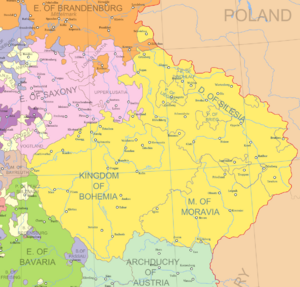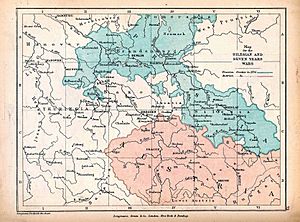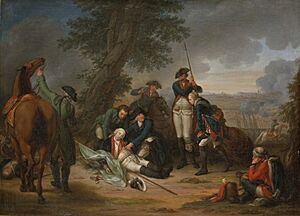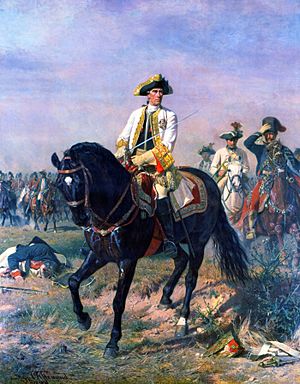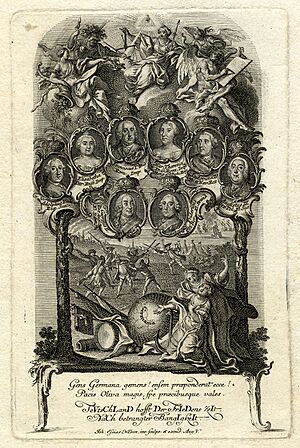Third Silesian War facts for kids
Quick facts for kids Third Silesian War |
|||||||
|---|---|---|---|---|---|---|---|
| Part of the Seven Years' War and the Silesian Wars | |||||||
 Prussian grenadiers advancing at the Battle of Leuthen, as depicted by Carl Röchling |
|||||||
|
|||||||
| Belligerents | |||||||
| Commanders and leaders | |||||||
|
|
||||||
| Casualties and losses | |||||||
The Third Silesian War was a big fight between Prussia and Austria from 1756 to 1763. It was part of a larger conflict called the Seven Years' War. This war was all about who would control a region called Silesia, which is now in Poland. In the end, Prussia kept control of Silesia.
This war was the last of three Silesian Wars fought between Frederick the Great, the King of Prussia, and Maria Theresa, the ruler of Austria. All three wars ended with Prussia holding onto Silesia. After the previous war, Austria made many changes and new alliances to get ready to fight Prussia again. Prussia started this war to stop its enemies' plans. It was a very costly war for both sides. It ended without a clear winner, as both sides were too tired to keep fighting.
The war started when Prussia invaded Saxony in 1756. It ended in 1763 with the Treaty of Hubertusburg. This treaty confirmed that Prussia would keep Silesia. No land changed hands, but Austria agreed to let Prussia keep Silesia. In return, Prussia supported Maria Theresa's son, Joseph, to become the Holy Roman Emperor. This war made Prussia much more important in Europe. Frederick the Great also became known as a brilliant military leader.
Contents
Why the War Started
The Seven Years' War was a huge global conflict. But in Central Europe, it was mainly about old disagreements from the War of the Austrian Succession (1741–1748). That war ended with Prussia's King Frederick the Great taking Silesia from Austria. But Empress Maria Theresa of Austria wanted Silesia back. She also wanted Austria to be the strongest power in the Holy Roman Empire. So, after the peace, she rebuilt her army and looked for new friends.
Old Problems and New Friends
Even though other countries agreed Prussia could have Silesia, Austria never fully accepted it. Maria Theresa's husband, Francis I, who was the Holy Roman Emperor, didn't promise Prussia would keep Silesia. In return, Prussia questioned Maria Theresa's right to rule Austria.
Other countries also had their own reasons to be involved. The British King George II saw Prussia as a friend of France. Empress Elizabeth of Russia worried about Prussia's growing power. She feared it would stop Russia from expanding west. So, more fighting seemed likely.
In 1746, Maria Theresa and Empress Elizabeth made a deal called the Treaty of Two Empresses. They agreed to work together against Prussia. They even had a secret plan for Russia to help Austria get Silesia back. In 1750, Britain joined them. Britain promised to help Austria and Russia if Prussia attacked Hanover, which was also ruled by King George. Maria Theresa also started to become friends with France, who had been Austria's enemy for a long time.
Changing Alliances
Things got more tense in 1755. Britain offered to pay Russia to send an army to attack Prussia. Frederick the Great was worried about being surrounded. He tried to get Britain to leave the Austrian group. On January 16, 1756, Prussia and Britain signed the Convention of Westminster. Prussia promised to protect Hanover from France. In return, Britain stopped offering money to Russia. This created a new alliance between Britain and Prussia. France was very angry about this.
Austria wanted to be friends with France so France wouldn't help Prussia. King Louis XV of France agreed to be friends with Maria Theresa. They signed the First Treaty of Versailles in May 1756. This big change in alliances was called the Diplomatic Revolution. Russia was also upset about losing Britain's money. So, Russia became closer to Austria and France. By April 1756, Austria, Russia, France, and other German states formed a strong group against Prussia.
Getting Ready for War
Austria and Russia were clearly getting ready for war. Frederick believed Prussia would be attacked in early 1757. Instead of waiting, he decided to attack first. He planned to invade Saxony, because he thought Saxony was secretly helping his enemies.
Frederick's plan had three parts:
- First, he would take over Saxony. This would give him more land and money for his army.
- Second, he would move from Saxony into Bohemia. He hoped to stay there for the winter and use Austria's supplies.
- Third, he would invade Moravia from Silesia. He wanted to capture a fortress called Olmütz and then march on Vienna, Austria's capital, to end the war quickly.
Frederick split his army into three groups. One group of 20,000 men guarded against Russia in East Prussia. Another group of 25,000 men stayed in Silesia to stop attacks from Moravia and Hungary. In August 1756, Frederick himself led the main army of 60,000 men into Saxony. This started the Third Silesian War.
How Wars Were Fought Back Then
Wars in the 1700s used guns and swords. Soldiers mostly used muskets with bayonets. Cavalry (soldiers on horseback) used swords and pistols. Light cavalry scouted and sent messages. Heavy cavalry were used for strong attacks. Cannons helped in battles and were very important for attacking fortifications.
Armies in this time were very organized. Governments paid for soldiers and their supplies. Armies often took money and supplies from enemy lands. But they usually didn't harm regular people like in earlier wars. Getting supplies was very important. Armies were too big to find all their food and supplies by just taking them from the land. Supplies were kept in big storage places and moved by wagons. These wagons were easy targets for enemy attacks. Armies usually stopped fighting in winter and started again in spring.
The War Begins
1756: Prussia Invades Saxony
Prussian troops crossed into Saxony on August 29, 1756. The Prussian army marched in three groups. Saxony and Austria were not ready for Frederick's quick attack. The main Saxon army gathered at Pirna. The Prussians took Dresden, the capital of Saxony, on September 9 with little fighting.
Frederick and his main army moved into northern Bohemia. They wanted to fight the Austrian army before it could join the Saxons. The Austrians fought the Battle of Lobositz on October 1. The battle was not a clear win for either side. The Austrians caused many losses for Prussia but then retreated. Frederick stopped the Austrians from helping the Saxons. The Prussians then fully took over Saxony. The Saxon army surrendered on October 14. Their soldiers were forced to join the Prussian army. Prussia also took all of Saxony's money to pay for the war.
1757: Big Battles and New Enemies
Winter Plans
During the winter of 1756–1757, both sides worked to get their allies ready. In February, Britain decided to fully support Prussia against Austria and France. Britain started sending money and supplies to Prussia. Britain also sent an army to protect Hanover from a French invasion.
However, Prussia's attack on Saxony made Austria's allies even more determined. In January, the Holy Roman Empire declared war on Prussia. In May 1757, France and Austria made their alliance stronger. France promised many soldiers and money to help Austria get Silesia back. In return, Austria promised France control of the Austrian Netherlands after the war. Russia also promised 80,000 soldiers. Sweden also agreed to invade Prussian Pomerania. The Austrian group wanted to divide Prussia among themselves. They tried to make Frederick look like the one who started the war.
Bohemia and the Battle of Kolín
After winter, Frederick decided to invade Bohemia again. He wanted to do this before French or Russian armies could arrive. On April 18, 1757, the main Prussian army moved into Bohemia. They wanted to fight the Austrians. On April 21, the Prussians won a small battle at Reichenberg. They continued towards Prague.
The Prussians met the main Austrian army near Prague. On May 6, they fought the Battle of Prague. Both sides lost many soldiers. The Prussians forced the Austrians back into Prague and started to besiege the city. An Austrian commander, Count Daun, arrived with more soldiers. He collected thousands of Austrians who had escaped the battle.
Frederick had to split his army to fight Daun and continue the siege. He took some soldiers from the siege to fight Daun. On June 18, they fought the Battle of Kolín. The Austrians won a big victory. The Prussians had to stop the siege and leave Bohemia. This ruined Frederick's plan to march on Vienna.
East Prussia and Pomerania Attacked
While Prussia was losing in Bohemia, new enemies joined the war. In mid-1757, a Russian army invaded East Prussia. They defeated a smaller Prussian force on August 30 in the Battle of Gross-Jägersdorf. But the Russians ran out of supplies and had to retreat. This helped East Prussia hold out longer. Sweden also declared war on Prussia in September. They invaded Prussian Pomerania. Prussia had to defend its own lands, which made it harder to fight in Bohemia and Silesia.
Battle of Rossbach

In mid-1757, Austrian forces moved into Lusatia. A combined French and German army also approached from the west. On September 7, the Austrians defeated a Prussian force at the Battle of Moys. The Prussian commander, Winterfeldt, was killed.
Frederick then led his army west into Thuringia. He wanted to fight the French and German army before it could join the Austrians. But the enemy avoided him. On September 10, Hanover and the British army surrendered to France. This left Prussia's western side open. In October, a small Austrian group briefly took over Berlin, Prussia's capital. They demanded money from the city.
On November 5, a Prussian army found the much larger French and German force near Rossbach in Saxony. The Battle of Rossbach was a huge Prussian victory. Frederick lost fewer than 1,000 men, while the enemy lost about 10,000. This win secured Saxony for Prussia. After this embarrassing defeat, France became much less interested in the Silesian War.
Battle of Leuthen

While Frederick was fighting in the west, the Austrian army moved into Lower Silesia. In November, they reached Breslau. They defeated the Prussian army there on November 22 in the Battle of Breslau. The Prussian commander was captured. The Austrians then took Breslau on November 25.
When Frederick heard about Breslau, his army marched very quickly to meet the retreating Prussians. His army now had about 33,000 men. They arrived near Leuthen on December 5. There, they found 66,000 Austrians. Even though his soldiers were tired, Frederick attacked the larger Austrian force and won another amazing victory in the Battle of Leuthen. The Prussians chased the defeated Austrians back to Bohemia. The Austrians and French still in Breslau were besieged until they surrendered on December 19–20. This brought most of Silesia back under Prussian control.
Winter Moves
After this big defeat, the Austrian commander Prince Charles was replaced by Daun. Frederick hoped his victories would make Maria Theresa want peace. But she was determined to get Silesia back. Prussia had spent all its money in 1757. It had to print more money and tax Saxony and the Catholic Church in Silesia to get funds. Frederick sent most of his East Prussian forces to Pomerania. The Prussian army quickly pushed the Swedes back and blocked their capital at Stralsund. Prince Ferdinand, now leading the Hanoverian army, drove the French out of Hanover and across the Rhine river. This made Prussia's western side safe for the rest of the war.
1758: More Fighting and Supply Problems
Moravian Campaign
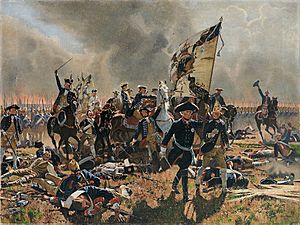
In January 1758, a Russian army invaded East Prussia again. Frederick let them have it, deciding it wasn't worth fighting for. He wanted to focus on winning in Silesia to force Austria to make peace. In March, France greatly reduced its money and soldiers for Austria. As the Prussian-Hanoverian army pushed the French out of northern Germany, Britain and Prussia argued about their alliance.
On April 11, Britain and Prussia made their alliance formal. Britain promised to give Prussia money every year and not make a separate peace. Britain also sent 9,000 soldiers to help. Frederick decided it was time to invade Moravia and take the city of Olmütz, as he had planned earlier. The last Austrian stronghold in Silesia surrendered on April 16. Frederick then led his army into Moravia and started to besiege Olmütz on May 20.
Olmütz was well defended, and the siege was hard. Frederick hoped to make Austria attack him directly. But Daun avoided direct fights. Instead, he focused on attacking Prussia's supply lines. By late June, the city's defenses were damaged, but the Prussian army was running out of supplies. On June 30, Austrian forces attacked a huge supply convoy going to the Prussians at Olmütz. They destroyed it in the Battle of Domstadtl. After this loss, the Prussians had to stop the siege and leave Moravia. This was Prussia's last major invasion of Austrian land during the war.
Battles of Zorndorf and Hochkirch
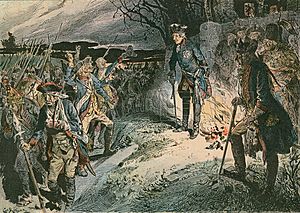
After failing in Moravia, the Prussians strengthened their defenses in Saxony and Silesia. Frederick led an army north to fight the Russians, who had reached Brandenburg. The Prussians who had been besieging Stralsund joined Frederick. On August 25, a Prussian army of 35,000 men fought a Russian army of 43,000 at the Battle of Zorndorf. Both sides fought very hard and lost many soldiers. The Russians retreated, and Frederick claimed victory.
The Prussians then went back to Saxony. They moved against Daun's Austrians, avoiding big battles. On October 14, Daun surprised the main Prussian army near Hochkirch in Lusatia. The Austrians won the Battle of Hochkirch. The Prussians lost many cannons and supplies, and their commander Keith was killed. But the survivors retreated in good order. The Prussians quickly regrouped and went into Silesia to break an Austrian siege of Neisse on November 7. After this, they returned west to protect Dresden.
Winter Quarters
After heavy losses at Zorndorf, the Russian army went back to the Baltic coast. They did not attack Prussia again in 1758. The Swedes attacked again in September but then retreated for the winter. Even with their win at Hochkirch, the Austrians did not make much progress in Saxony. They could not retake Dresden. The Austrians had to go back to Bohemia for the winter, leaving Saxony under Prussian control. The Prussian army worked to rebuild itself.
1759: A Close Call
Battle of Kunersdorf
In April 1759, Frederick led his main army into Lower Silesia. He wanted to keep the Russian army in Poland separate from Austria's army in Bohemia. A smaller Prussian force under Frederick's younger brother, Prince Henry, stayed in Saxony. He won some small battles and destroyed Austrian supplies. The Russians continued to push into Neumark. On July 23, the new Russian commander defeated a Prussian force at the Battle of Kay. The Russians moved west towards the Oder river. Frederick brought more soldiers to face the Russians.
On August 3, the Russians reached Frankfurt an der Oder. They received many Austrian soldiers there. Frederick was determined to push back the Russians, who were now close to Berlin. On August 12, he attacked the Russian position at Kunersdorf. The Battle of Kunersdorf was a huge win for Russia and Austria. It completely scattered the Prussian army. Frederick thought the war was lost. But the allies did not chase the defeated Prussians or take Berlin.
The Russians had many losses at Kunersdorf. Also, the Russian and Austrian leaders disagreed. The Russian commander held back his forces, giving Prussia time to regroup. Russia's supply lines were long and difficult through Poland. Prince Henry's actions in Saxony also threatened to cut the Austrians' supplies. In September, even though they had many more soldiers, both the Russians and Austrians went back into Silesia. The allies' disagreements and slow actions gave Prussia a second chance. Frederick later called this the "Miracle of the House of Brandenburg".
Saxon Campaign
In early September, Austrian forces moved into Saxony. Dresden surrendered on September 4, and the Austrians quickly took most of Saxony. Prince Henry's army marched west to fight for Saxony again. His soldiers defeated a larger Austrian force on September 21 at the Battle of Korbitz. Daun sent more soldiers into Saxony, but Prince Henry's Prussians destroyed them on September 25 at the Battle of Hoyerswerda. Daun then moved his main army into Saxony, leaving the Russians, who went back to Poland for the winter.
In November, a Prussian group was surrounded and defeated by Austrians at the Battle of Maxen on November 21. Another small Austrian victory happened at the Battle of Meissen on December 4. This ended the fighting for the year.
1760: Back and Forth Battles
Lower Silesian Campaign
In early 1760, the Austrian commander Laudon started his own campaign in Silesia. He besieged Glatz on June 7. A Prussian force tried to help Glatz, but Laudon defeated them on June 23 at the Battle of Landeshut. Frederick led his main army east to defend Silesia. But he turned back when he learned Daun's main army was also moving that way. Frederick then went back into Saxony and besieged Dresden on July 13. He hoped to take Dresden quickly or distract the Austrians. But Daun's army marched west and forced the Prussians to stop the siege on July 21.
Glatz was taken by the Austrians on July 29. The Austrian armies then joined together in Lower Silesia. The Prussians tried to unite and fight a big battle. Laudon's army attacked Frederick's position near Liegnitz on August 15. The Battle of Liegnitz was a Prussian victory. The Prussians defeated Laudon before Daun's larger army could arrive. This win helped Prussia regain control of Lower Silesia.
Battle of Torgau
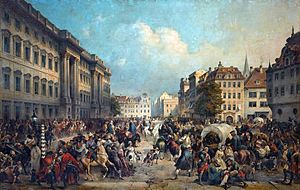
A smaller Prussian force stopped an Austrian attack into Saxony on August 20. The Prussians and Austrians spent September fighting small skirmishes in Silesia. The Russians stayed back in Poland. With Prussian forces in Silesia and Saxony, Berlin was left unprotected. In early October, Russian and Austrian soldiers briefly occupied Berlin. They demanded money and freed prisoners. But the Russians soon left for lack of supplies.
The main Prussian and Austrian armies finally met on November 3 near Torgau. The Battle of Torgau was very costly for both sides. In the end, the Prussians controlled the battlefield and claimed victory. But both armies were very weak and went to winter quarters. Prussia's victory at Torgau did not gain much. Daun still held Dresden, and Laudon's army was still strong in Silesia. Prussia had to print more money again. The Austrians were very disappointed. Their money problems were also getting worse. Both sides were so tired that they could not win the war without outside help.
1761: Running Out of Everything
Low on Resources
By early 1761, neither side had enough soldiers or supplies for a big attack. Prussia only had 104,000 soldiers, many of them new. They even lacked basic things like muskets. The Prussian army could no longer make the aggressive moves Frederick was known for. The country was in a terrible situation. The main Austrian commander, Daun, also decided not to launch big attacks. Austria's money was a mess, and heavy war taxes hurt its economy. Russia and Austria were also not working well together.
Russian Progress

The new Russian commander worked with Austria to advance in southern Silesia in April. The Prussian army dug in around Schweidnitz. The armies moved around for a long time without any major battles. The allies ended the campaign by taking the fortress at Schweidnitz on October 1. The Prussians then went to winter quarters.
Meanwhile, Russian forces had besieged the Prussian port of Kolberg starting on August 22. The town was well defended. Several Prussian attempts to break the siege failed. In October, Frederick ordered many soldiers to leave Kolberg and defend Berlin. The weakened town finally surrendered on December 16. Losing Kolberg meant Prussia had no port on the Baltic Sea. It also gave Russia a way to supply its armies by sea, which was much easier than by land. This could have turned the war against Prussia the next year.
1762: The "Second Miracle"
By 1762, the Prussian army had only 60,000 men. It seemed Prussia was about to collapse. Britain even threatened to stop giving money to Prussia if they didn't make peace. Then, on January 5, 1762, the Russian Empress Elizabeth died. Her nephew, Peter III, became Emperor. He was a big fan of Frederick's. He immediately stopped fighting Prussia.
Peter agreed to a ceasefire with Prussia in March. He ended Russia's control of East Prussia and Pomerania. On May 15, Russia and Prussia formally ended their war with the Treaty of Saint Petersburg. This confirmed Prussia's borders. Peter also helped end the war between Prussia and Sweden. He even put 18,000 Russian soldiers under Frederick's command. This was called a second "Miracle of the House of Brandenburg."
Meanwhile, France was tired of the war. British blockades, defeats in other parts of the world, and no progress in Germany wore them down. After Russia and Sweden left the war, France realized it wouldn't get the Austrian Netherlands. Austria was almost bankrupt. Without French money, Maria Theresa could not invade Silesia again. France also agreed to a ceasefire with Frederick. France left Prussia's lands in the Rhineland, ending its part in the war in Germany.
Final Fights
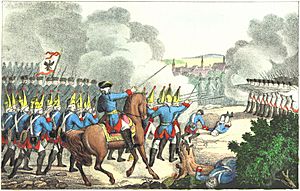
With its sides now safe, Prussia focused all its strength on Austria. The Prussian army grew bigger with soldiers from the north and the Russians. In June, the Prussians marched to fight for Silesia again. However, on July 9, Peter III was removed from power by his wife, Empress Catherine II. Catherine immediately pulled her Russian soldiers from Frederick's command, but she did not rejoin the war on Austria's side.
Even without the Russian help, the Prussians fought Daun's army on July 21 near Burkersdorf. Frederick convinced the Russian commander to stay nearby, making the Austrians think they might still attack. The Prussian victory in the Battle of Burkersdorf led to them taking back most of Silesia. The Prussians then besieged Schweidnitz, recapturing it on October 9. Prussia had won its final Silesian campaign.
In the next months, Prince Henry led an army into Saxony. He fought the Austrian defenders near Freiberg on October 29. The Battle of Freiberg was a Prussian victory. Prussian forces then took most of Saxony. In November, Maria Theresa suggested peace talks. Frederick agreed right away. On November 24, both sides agreed to stop fighting in Saxony and Silesia. Peace talks began in late December.
A Standoff
By the end of 1762, Prussia had taken back almost all of Silesia. It also controlled most of Saxony, except for Dresden. Austria still held Dresden and a small part of southeastern Saxony, along with a region south of Silesia. The fighting countries in Central Europe had basically reached a tie. Prussia's money was stable, but the country was ruined by battles and enemy occupation. It had no more men to fight. Austria was facing a huge money crisis. It had to make its army smaller. Without Russian soldiers or French money, Austria had little hope of getting Silesia back. Other countries in the Seven Years' War had already started peace talks. So, on December 30, negotiators from Austria, Prussia, and Saxony met to discuss peace.
1763: The Peace Treaty
Treaty of Hubertusburg
Frederick had thought about giving East Prussia to Russia for their help in taking Saxony. But Catherine's withdrawal meant Russia was no longer fighting and didn't join the peace talks. The fighting countries agreed to simply give back the lands they had taken from each other. Austria would leave Glatz, giving Prussia full control of Silesia. In return, Prussia would leave Saxony, giving it back to its ruler. Saxony would not get any money from Prussia. With these agreements, the borders went back to exactly how they were before the war. Austria also formally gave up its claim to Silesia. In return, Prussia promised to support Maria Theresa's son, Joseph, in the next election for Holy Roman Emperor. With that, the countries agreed to end the Third Silesian War with the Treaty of Hubertusburg, signed on February 15, 1763.
What Happened After the War
The peace treaty meant that no country gained new land. Prussia did not keep any part of Saxony. Austria did not get Silesia back. Russia did not gain any land from Prussia. However, the war is generally seen as a win for Prussia. Prussia not only kept Silesia but also made Austria officially agree to its control of the region. This stopped any more Silesian Wars. More importantly, Prussia showed it could stand up to Austria. It survived a war that could have split it apart.
Prussia's Future
Prussia became a new great power in Europe after the war. It was now the leading power in Protestant Germany. The country was recognized as the owner of Silesia, ending Austria's attempts to get it back. Frederick the Great's fame grew hugely. People forgot how much he owed to luck (Russia's change of heart) and British money. Instead, they remembered his strong leadership and clever victories. Prussia had survived being invaded by Austria, Russia, Sweden, and France all at once. This seemed like a miracle to people at the time. After 1763, armies from all over the world sent their officers to Prussia to learn its military secrets. Prussia became one of the most copied countries in Europe.
Even though it was a big step for Prussia, the war left the country's economy and people devastated. Frederick spent much of the rest of his rule fixing the damage. To make up for lost people, he encouraged Protestant refugees to move to Prussia. The constant printing of more money to pay for the war caused prices to rise quickly and hurt the economy. After the war, the government used its military grain stores to keep food prices stable. Prussia also started a basic system to help poor and injured war veterans.
Prussia's army had many losses in the war, with about 180,000 men killed. After the peace, the country did not have enough money or people to rebuild the army to its old strength. By 1772, Prussia's army had 190,000 men, but few officers were veterans of the Silesian Wars. In later wars, the Prussian army did not do as well. It was only after big changes in the early 1800s that Prussian military power grew strong again.
Austria's Changes
The war left Austria deeply in debt. Its army was much weaker, with over 145,000 men dead or missing. Austria could not get Silesia back or gain any new land. But it did keep Saxony from Prussia, which slowed down its new rival's growth. Austria's army fought much better than in the previous war. This showed that Maria Theresa's changes to the government and military had worked. So, the war helped Austria regain its importance in Europe. By agreeing to vote for Joseph as Holy Roman Emperor, Frederick accepted that Austria would still be important in the Holy Roman Empire.
Prussia becoming a strong power and its king and army gaining fame were long-term threats to Austria's power in Germany. The Silesian Wars made it clear that Austria needed to make big changes to stay strong. After the disappointment of the Third Silesian War, Maria Theresa finally gave up hope of getting Silesia back. She focused instead on changes within Austria to prepare for future fights with Prussia.
In 1761, Austria created new central government groups to make decisions faster. In the 1760s and 1770s, they worked hard to collect more taxes, especially in certain regions. This led to a big increase in government money. In 1766, the crown created its first common set of laws. Maria Theresa also made rules to limit forced labor for peasants. Her son continued this with his Serfdom Patent. The government also started required primary education and public schools. These changes, known as the Theresian reforms, helped modernize Austria for the next 50 years.



